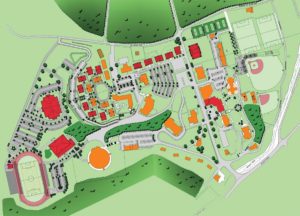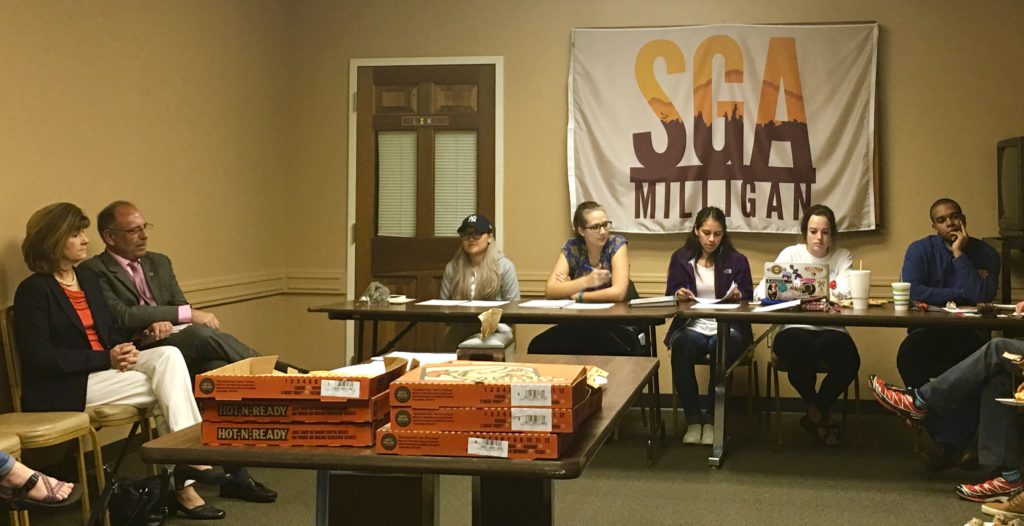(President Greer opened the Q&A with a discussion regarding fundraising plans and campus advancements.)

“Many of you may not know this, but we are in the midst of the tail end of a comprehensive capital campaign for Milligan. This document here, as the campaign brochure, is the collection of fundraising priorities. I assume that you guys know we are a private college, which means that we don’t get state or federal funding for things. So, that means that we are dependent on tuition and gift income. The gift income comes from alumi mainly and other donors who are friends of the school.”
“We are very active in fundraising so that we can keep the school going, keep it growing and keep it operating to meet the needs of the students. In this capital campaign we are trying to raise $40 million to complete the projects in the brochure, and we’ve already raised almost $39 million, so we are almost done with this one, and when we are, we will start another one which will contain anything from this campaign that wasn’t funded and more.”
“If you look at the Campus Master Plan, you can see that anything that is in red is proposed for the future, and anything that’s orange is already here. So you can see at the Village the five orange buildings that exist, but there’s room up there for several more. Which means as enrollment grows and as we have the financing, that is where we will likely put future housing.”
“One thing you might notice, especially if you live in Webb, is that it’s gone. In its place you can see more housing that would be similar to the Village. You also can see parking lots where Kegley and Quillan are currently. The reality of this is, I don’t know when all of these will be funded, because there’s a lot of them… Now in a master plan like this it could be ten years, it could be twenty years; it’s hard to say. If the need is that we need more housing that could be sooner, or, if we happen to have the fortune to be blessed to connect with the right donor, I would love to get the track put in because the track is a priority. We’ve just not hit the right donor at the right time with it. So all we can do is keep it out there and continue to do the best we can to secure those funds.”

What is Milligan doing for handicap accessibility, and what more can be done?
“The geography of this campus makes it inherently difficult, so that is against us. It’s a great asset, but it also complicates everything we do… Every time we have to build something, we have to move a mountain to do it… So what we’ve had to do in the past is make special accommodations, for instance, for students who were wheelchair bound. That’s why there are ways — they may not be ideal — but there are ways to get in virtually every building that have met the federal ADA requirements that we have had to meet every step of the way. As for new construction, like the Village, some of the suites that are on the ground floor are fully handicap accessible. When we renovated Derthick, we made sure there was a ramp in the right place. We are very mindful of those sorts of things and do the best we can. There are some buildings that are more prohibitively expensive, so we’ve had to figure out other creative ways to meet the needs, and we have. I just want to say we are not insensitive to it; we just have to work within the resources we have.”
Why can’t everyone have an air conditioning unit?
“Good question. This is something I care a lot about. I assume we are mainly talking about Webb and Sutton. The problem with just putting in air conditioning units is that the electrical feed to that building is not sufficient to run an air conditioner in every room; it would explode or whatever the electrical equivalent is. So we have looked on occasion at the possibility of upgrading all the wiring, but it’s literally a multimillion dollar task to be able to plug in an air conditioner in every room. At the end of the day it’s a big investment for what is a relatively short window of time in which it will be really needed, and that’s the challenge. It’s hard to justify the many millions of dollars to do that. A better solution is just to eliminate the building and replace it down the road; unfortunately, that’s where we are.”
Can Milligan make recycling a bigger deal?
“I know that in the past years that has been a student government project; it comes and goes based on student level of interest, so some years there is a lot going on, and some years there is less. It may be something you can make an initiative… It will just have to be a community effort as it has been in the past; maybe we can revisit that initiative.”
What are the monitors outside the grill and caf for?
“The monitors are about to be dashboards where you can look and see how much water is being used in each dorm, how much electricity is being used in each dorm and every building on campus. There’s a bench mark that we want to achieve of savings from an energy and water conservation standpoint, and these dashboards will let us do it.”
Can there be a different sticker for Village residents?
“It’s a challenge, because we have more parking then we need for the Village, because there’s more buildings to build. But we went ahead and put a lot of parking in so that parking can serve as overflow for Hart and Sutton. The challenge of color coding is that it would suggest that only Village residents could park there, and then that lot would have a lot of empty space. If Hart and Sutton lots are full, those residents need to go to the Village, but if they have different stickers they can’t. It’s not fair to either of the residents. I would encourage the Village people to use the Village lot — because that’s what it’s there for — and be courteous to the residents of Hart and Sutton so they can park as close…to their dorms as they can. I get it; sometimes the question isn’t ‘Is there enough parking?’ but ‘Is there a parking spot where I want it to be?’. If everyone tries to park in their respective area, more spots are going to be available.”
Can we do anything about the caf food?
“I understand what it’s like. Some days the food is great; I love Fiesta Friday. You can cover everything with cheese, and that’s good. Some days they aren’t as creative with their leftovers, but they try. It’s hard to feed this many people three meals a day or however many you eat. I know they are open to suggestions… One student came to me and compared another school’s meal plan to ours. I looked at that meal plan, and it was literally twice as much per semester for food. We could charge twice as much, if you want us to, and have fancy food, but we try to have an affordable plan that’s of reasonable quality and healthiness. They are open to suggestions, and I’m happy to help.”
How do you expect to get to the goal of 2,000 students as the brochure suggests?
“That’s a long range goal. Just a few years ago we had 900 students, and now we are 1200. That’s a number that continues to grow incrementally. The goal of 2,000 isn’t to say that in the next three or four years there’s all of a sudden going to be 2,000 students. It’s important from a financial standpoint for the college and the economic growth of the college to have that incremental growth.There’s no hurry to get there, I would like us to slowly grow, because that helps us keep tuition rates down. As much as it does cost, we are at a bargain compared to most private colleges, and we want to keep that rate down as much as we can.”
Will increase of students impact tuition increases?
“My goal is for (tuition) increase(s) to get smaller. I want to get it down to 3 percent or 2 percent; this year it’s a little over 3 percent. I’d like it to be in the twos. Inflation is a reality, but I would like for any tuition rates in the future to be closer to the inflation rate rather than a lot higher. A way to get there is to make sure we’re bringing in a few more students each year, because it helps spread the cost. I think it’s also important from a Christian standpoint, as we want more of our students out in the workplace and have the impact that they are gonna have.”
Are there plans to switch athletic divisions?
“That’s a really complex question. We are constantly evaluating our athletic affiliation. We have conducted some really in depth studies as to whether to be NAIA affiliated or NCAA affiliated. At this point there’s not any sort of driver to make a change. We’ve been long term members of the NAIA, and I think that their values mirror ours. I like the focus the NAIA has in character and character development, whereas the NCAA has less of that.”

